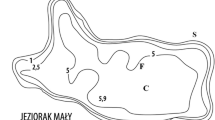Abstract
Lake
Finjasjön is a shallow, eutrophic lake (area 1100 ha, mean depth 3 m, maximum depth 13 m) in southern Sweden. In the 1920s, the lake was clear, with a summer Secci depth of about 2 m. During the first half of the 20th century, untreated sewage from the town polluted the lake. In the 1930s, the lake began to show eutrophic characteristics, and in the 1940s, the cyanobacterium Gloetrichia echinulata dominated in summer. In 1949, the first municipal sewage treatment plant was built. The treatment was, however, insufficient, since the lake continued to be the recipient of the effluent with the result that the occurrence of cyanobacteria became more frequent. Species such as Microcystis and Anabaena caused skin rash and allergic symptoms among swimmers. The phosphorus load on Lake Finjasjön increased as the population of Hässleholm grew and reached a peak value of 65 tons annum−1 in 1965. In 1977, the sewage plant was rebuilt to include chemical flocculation, reducing the total external phosphorus load to about 5 tons annum−1. Despite this improvement the lake did not recover from its chronic and toxic cyanobacterial blooms. Phosphorus-leaking black sediments were identified as the cause of the lake's failure to recover. Some 60% of lakebed area is covered with sediments on average 3 m thick. Dredging the sediments was started on a large scale in 1987. Five years later, 25% of the sediment area had been removed but the dredging was stopped since phosphorus continued to be released into the water from these areas. In 1992, a new restoration policy, a combination of further reduced external nutrient loading and food-web manipulation was initiated. A constructed wetland (30 ha) to reduce phosphorus and nitrogen was created in connection to the effluent from the sewage treatment plant. Protection zones along the feeder streams into Lake Finjasjön were also established. A cyprinid reduction programme by trawling was carried out between 1992 and 1994. When it started, the fish community was composed of 90–95% bream and roach. After two years of trawling, the ratio between piscivorous and planktivorous fish was 1:1. In 1994 and 1995, the transparency increased due to a considerably reduced biomass of phytoplankton and a radically altered phytoplankton community. The monoculture of Microcystis was replaced by a diverse phytoplankton community. The increased transparency made possible the development of submerged macrophytes such as Elodea, Myriophyllum and Potamogeton. The internal loading of phosphorus decreased dramatically in 1994 and 1995, possibly as a result of reduced sedimentation of phytoplankton.
Similar content being viewed by others
References
Aagren, R., 1994. Test fishing with benthic survey nets in Lake Finjasjön, Autumn 1994. Report. The Municipal Services Department, Municipality of Hässleholm.
Annadotter, H., 1990. Finjasjön – Badbar i vå r tid för vå ra barn? (Lake Finjasjön – able to swim in, in our time, for our children?). Report, The Municipal Services Department, Municipality of Hässleholm (in Swedish).
Annadotter, H., 1993. Algtoxiner i dricksvatten. VA-Forsk rapport 1993-03. (In Swedish with an English abstract): 110 pp.
Annadotter, H., A. Larsson, E. Mattsson, L. Thunberg & T. Willén, 1990. Algtoxisk på verkan på nötkreatur. Rapport, Hässleholms gatukontor.
Annadotter, H., B. Lundstedt, & S. Ströbeck, 1992. Deklaration angå ende Finjasjöns fortsatta restaurering. Press release 1992-03-27, (in Swedish).
Annadotter, H., G. Cronberg, & L. Jönsson, 1993. The toxicity of blue-green algae (cyanobacteria) in Lake Finjasjön, Sweden in relation to Environmental Factors – A five-year study. In G. Giussani & C. Callieri (eds), Proceedings from the 5th International Conference on the Conservation and Management of Lakes, "Strategies for lake ecosystems beyond 2000".
Annadotter, H., 1995. Toxic blue-green algae in drinking water treatment. Vatten 51: 5–11. (In Swedish with an English abstract).
Annadotter, H., P-Å. Nilsson, B. Lundstedt, & S. Ströbäck, 1995. A new constructed wetland for combined reduction of phosphorus and nitrogen. Vatten 51: 103–106. (In Swedish with an English abstract).
Collvin, L. & J-I., Må nsson, 1990. Provfiske i Finjasjön 1990. Rapport, Hässleholms gatukontor.
Hå kansson, L. & Jansson, M. 1983. Principles of Lake Sedimentology. Springer Verlag, Berlin & Heidelberg.
Krug, A. & C. Walker, 1991. Tormestorpså n, Inventering och Åtgärdsförslag. Lunds universitet, Limnologiska avdelningen. (In Swedish).
Löfgren, S. & C. Forsberg, 1984. Finjasjöprojektet Report. Institute of Limnology in Uppsala. (In Swedish).
Löfgren, S. 1991. Finjasjön – miljösituation samt förslag till miljömå l och å tgärder. Utredning å t Gatukontoret, Hässleholms kommun. (In Swedish).
Nilsson, P-Å., 1990. Restaureringen av Finjasjön – Läge och strategi 1991. Report, Hässleholms gatukontor. (In Swedish).
Nilsson, P-Å., 1991. Finjasjön. Sedimentundersökning 1991. Rapport. Hässleholms gatukontor.
Nyberg, P. & E. Degerman, 1988. Information frå n Sötvattenslaboratoriet Drottningholm. Standariserat provfiske med översiktsnät. Nr 7. Institute of Freshwater Research of the Swedish National Board of Fisheries.
Ripl, W. & L. Leonardsson, 1980. Förstudie av fosforfastläggning genom inducerad denitrifikation vid sedimentytan i Finjasjön. Rapport Limnologiska institutionen, Lunds universitet & Hässleholms kommun, Gatukontoret. (In Swedish).
Vollenweider, R. A., 1976. Advances in defining critical loading levels for phosphorus in lake eutrophication. Mem. Ist. ital. Idrobiol. 33: 53–83.
Vought, L & J. Lacoursiére, 1992. Hovdalaå n, Inventering och Åtgärdsförslag. Lunds universitet, Limnologiska avdelningen. (In Swedish).
Vought, L & J. Lacoursiére, 1994. Svartevadsbäcken, Inventering och Åtgärdsförslag. Lunds universitet, Limnologiska avdelningen. (In Swedish).
Author information
Authors and Affiliations
Rights and permissions
About this article
Cite this article
Annadotter, H., Cronberg, G., Aagren, R. et al. Multiple techniques for lake restoration. Hydrobiologia 395, 77–85 (1999). https://doi.org/10.1023/A:1017011132649
Issue Date:
DOI: https://doi.org/10.1023/A:1017011132649




